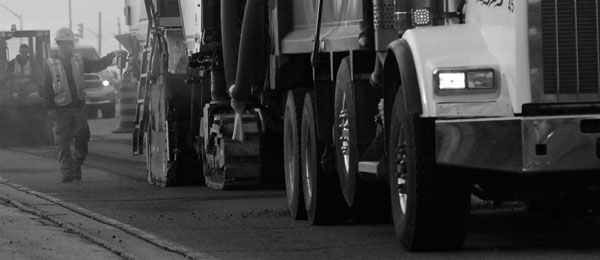A new-to-Canada 3D scanning technology developed by a Czech company called Control Systems CA has been successfully used to shave-and-pave stretches of highway in the Sudbury and Orangeville areas.
The scanners provide a very precise, in-depth profile of a roadway to determine how far down asphalt needs to be removed. Only the necessary asphalt is stripped during the road rehabilitation process, thereby reducing the construction time and surplus materials on a project.
The process is quite technical but has the potential to reduce the amount of wasted materials, and slash construction time by 25 per cent which results in cost savings, and lower carbon emissions.
“Using advanced and very complicated computer processing we prepare an optimal digital design model for milling and paving,” explains Vitek Obr, chief technology officer and business development manager at the firm, which specializes in laser scanning technologies for mining and construction.
“In this digital process we can identify all problematic areas and solve all problems before we start the milling. This process is very complicated but saves a lot of time in the field which is significantly more expensive.”
Road rehabilitation in Canada often does not involve any type of scanning. Traditionally, milling machines are set to take off a fixed depth of asphalt. Control Systems CA uses Exact Street 3D differential milling which enables operators to use data to adjust the amount of asphalt to be removed.
The technology runs a scan that enables operators to see abnormalities in the pavement and issues like soft spots or areas where water pooling may be present. The data is automatically relayed to the operators.
The technology reduces milling depth in areas of a road that are already low, such as sunken culvert, ruts or potholes, and increases milling in higher points of the road.
According to Control Systems CA, the precise measurements enable pavers to improve the water drainage profile of roads, provide uniform asphalt depths, and lay down a smoother surface.

The technology is used to create a so-called “digital twin” of the road to be rehabilitated. The replica is essentially a very detailed digital model of the road surface. The models are uploaded to a differential milling unit computer which automatically controls the hydraulics of milling machines.
The milling control does not require assistance from a surveying crew or specialist to guide the milling machines. It uses horizontal positioning data from a GPS to set the correct milling depth.
The milling machine “recognizes” the correct milling depth of any road location from the data of the GPS horizontal position, which ultimately results in less asphalt being transported for disposal.
“The milling machine knows exactly what the correct milling depth in any road location, based on GPS horizontal position data,” explains Obr.
Three-dimensional milling is especially helpful for projects in remote locations, where recycled asphalt is in high demand, he says.
For example, a project could have its profile adjusted so that additional recycled asphalt is generated to increase nearby quarry stocks. Alternatively, for a project in a busy, urban centre where existing recycled asphalt stockpiles are significantly full, the model could be adjusted so that the resulting recycled asphalt production is limited.
Obr says the technology will make roads smoother, safer and more comfortable for driving on and also lead to roads that last longer.
“The road construction time and amount of excess milled materials will also be reduced, which will therefore result in fewer CO2 emissions from milling.”
While each project is different, Obr notes that the technology can achieve more than 25 per cent savings on materials as a result of less milling.
“The milling operation is often taking place in full traffic and is dependent on its intensity as well as on the weather,” says Obr. “The project manager often has to make quick decisions when and where to mill based on these factors. The Exact Street precalculated database of milling depths enables the milling to start and re-start anywhere as required without any extra preparations.”
While there are several global players in the 3D scanning technology market, they are producers of surveying equipment and focus on selling hardware and not the entire process of milling.
In addition to the Canadian projects, the technology has been used on thoroughfare rehabilitations in Norway, Sweden, Finland and the Czech Republic.
In 2019, the technology was used on a seven-kilometre road rehabilitation in Orangeville and saved 46 per cent of the asphalt from going to the dump. Last summer, it was used on a five-kilometre stretch of Highway 17 near Sudbury and the project was finished days ahead of schedule.
Ontario’s Ministry of Transportation has been working on new specifications for public road tenders that would require 3D milling on some thoroughfares which is a big step forward, according to Obr.
Meantime, the company is setting its sights on rehabilitating runways at airports. The runways could be milled using several machines at the same time. The technology was used at Stockholm International Airport in Sweden and also at the Prague International Airport in the Czech Republic.




Recent Comments
comments for this post are closed